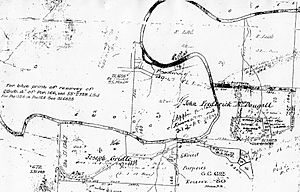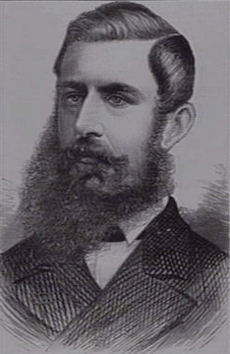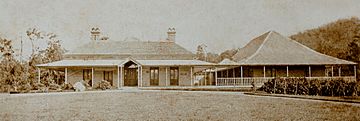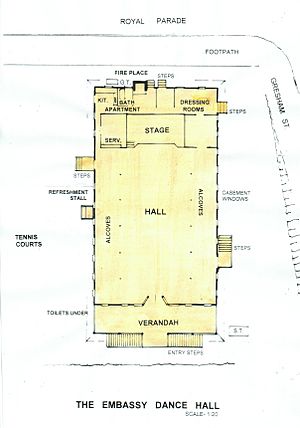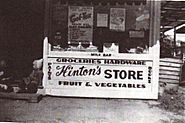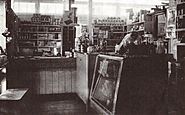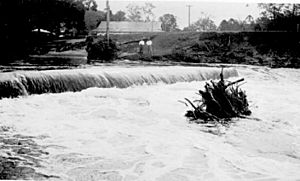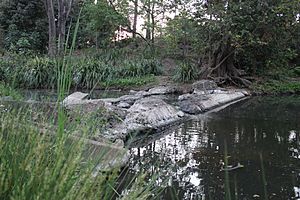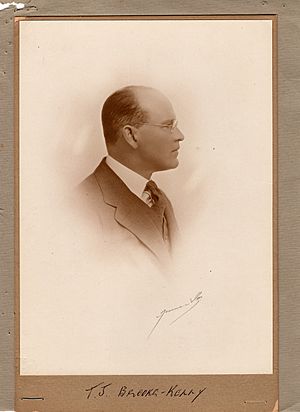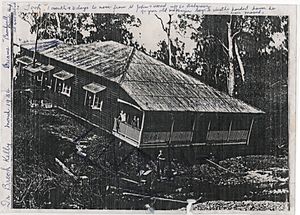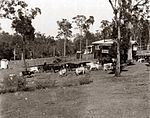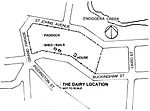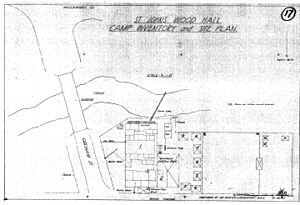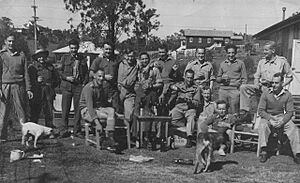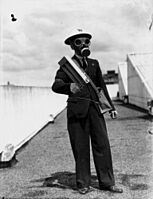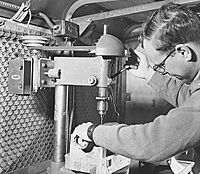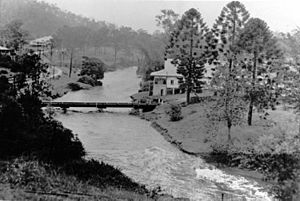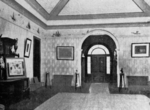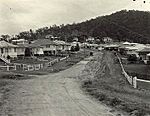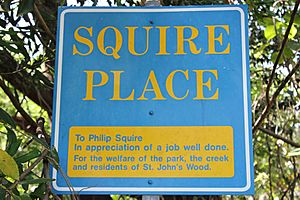St Johns Wood, Queensland facts for kids
Quick facts for kids St Johns WoodBrisbane, Queensland |
|||||||||||||||
|---|---|---|---|---|---|---|---|---|---|---|---|---|---|---|---|
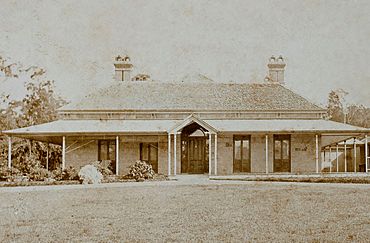
Granite House, St. John's Wood 1880
|
|||||||||||||||
| Established | 1858 | ||||||||||||||
| Postcode(s) | 4060 | ||||||||||||||
| Time zone | AEST (UTC+10) | ||||||||||||||
| Location | 6 km (4 mi) NW of Brisbane | ||||||||||||||
| LGA(s) | City of Brisbane, The Gap Ward | ||||||||||||||
| Region | South East Queensland | ||||||||||||||
| County | Stanley | ||||||||||||||
| Parish | Enoggera | ||||||||||||||
| State electorate(s) | Cooper | ||||||||||||||
| Federal Division(s) | Brisbane | ||||||||||||||
|
|||||||||||||||
St Johns Wood is a small neighbourhood in the Ashgrove area of Brisbane, Queensland, Australia. It's a residential spot located at the bottom of the Taylor Range. The area is surrounded by a bend in Enoggera Creek, the Ashgrove Golf Club, a Brisbane City Council park, and the Enoggera Barracks.
Before Europeans arrived, the land was home to the Indigenous Turrbal people. European settlement began in 1858. The famous homestead, St John's Wood House (also known as Granite House), was built in 1864. Today, this historic house still stands on a small piece of land, while the rest of the area has been divided into housing blocks. St Johns Wood is also home to the St Johns Wood Scout Group and The Woods Early Education Centre & Pre-school. You can get to the neighbourhood by car, bike, or on foot using bridges.
Contents
- Indigenous History: The Turrbal People
- Early European Settlement
- The St Johns Wood Estate and Granite House
- Embassy / Ambassador Hall: A Community Hub
- The Weir: A Community Lake
- A House Moves to Become a Hospital
- The Dairy Farm
- St Johns Wood During World War II
- St Johns Wood Scout Group
- Flooding in St Johns Wood
- Architecture of St Johns Wood Homes
- Community Groups in St Johns Wood
- Transport in St Johns Wood
Indigenous History: The Turrbal People
The St Johns Wood area, known as "Kallindarbin" by its first inhabitants, was originally home to the Indigenous Turrbal people. The main road, Waterworks Road, was built on an old Turrbal path. This path led to Mount Coot-tha, a special place known as the "Honey-Bee Dreaming."
The waterholes and dense bushes along Enoggera Creek provided everything a hunter-gatherer society needed. The rainforests and eucalyptus forests offered fresh water and food. Yams, black beans, and wild figs, which still grow along the creek today, were important food sources. The Turrbal tribe spent their days hunting, gathering food, playing games, and taking part in social and spiritual activities. As more Europeans settled, the Turrbal people were eventually moved from their traditional lands.
Early European Settlement
When the first Europeans arrived, they found fertile land along Enoggera Creek. This land was perfect for farming. Beyond the creek, in the foothills of the Taylor Range, the soil was good for grazing animals. These features shaped how the land was sold, first for lease and then for private ownership.
The first official use of the area by Europeans was in 1849. This is when the first land leases along Enoggera Creek were offered for sale. Darby McGrath leased 7020 acres, including St Johns Wood, in 1851. This area was called 'The Gap Station' and he used it to raise sheep. Later, the land was sold as freehold property, starting in 1856.
The St Johns Wood Estate and Granite House
The original St Johns Wood estate was about 67 acres. It was first bought by John Frederick McDougall in 1858. He used it as a cattle station and had fences built around it. Later, in 1864, Daniel Rowntree Somerset bought the land. He started building a "magnificent home" using granite from the nearby hills. He named the estate St John's Wood after his son, Henry St John Somerset.
The Harding Family and Granite House
In 1868, Daniel Somerset leased the property to George Rogers Harding, a young lawyer who later became a famous judge. Harding bought the property in 1874. He made the homestead, known as "The Granite House," much bigger. He added a ballroom and built a separate building called the "Cedar House" for his growing family. He also added stables and an orange orchard. The property was very large, with many rooms including a drawing room, dining room, library, and several bedrooms.
Fun Times at St Johns Wood House
The Harding family loved to entertain guests at their home. They were famous for their banquets and parties. In 1881, they hosted a masquerade dance in their ballroom. A menu from 1884 shows guests enjoyed six courses, drinks, and coffee. In 1892, a "large and brilliant gathering" of about 500 people, including important government officials and judges, enjoyed music and a pleasant evening.
St Johns Wood Housing Estate
After George Rogers Harding passed away in 1895, the property was sold in 1917 to Francis Michael Anglim. Anglim first used the land to breed horses. In 1923, he divided the land into smaller blocks and sold them as a housing estate, also named St John's Wood. The tramline to Ashgrove was completed the next year, which helped the area grow quickly.
In 1927, a newspaper article described St Johns Wood as a beautiful area where "people of wealth, repute and undoubted position" bought homes. This made St Johns Wood a symbol of "distinction and exclusiveness."
After Anglim died in 1931, Edward Albert Hawkins bought the property in 1934. He turned Granite House into two flats. He also bought an old school building and used its materials to build a Recreation Hall next to Granite House in 1936. In 1958, the property was divided again into six building blocks, making the Granite House plot much smaller.
Embassy / Ambassador Hall: A Community Hub
The Embassy Dance Hall, and later the Ambassador Theatre, was an important community building. It was built in 1928 and was made entirely of timber. It was a large hall with a stage, changing rooms, and a refreshment counter. People would come by tram and then a special bus, or walk, to attend events. There were also four flood-lit tennis courts next to the hall.
During World War II, from 1943 to 1945, the building was used by the Australian Army. It became a secret unit where chemical gases and weapons were tested.
In 1947, Bert Hyde bought the building and turned it into a movie theatre called the Ambassador Theatre. He added a projection room and a screen, and installed canvas seats. Movies were shown on Saturday nights. A small shop next to the theatre sold groceries to movie-goers and local residents.
When television became popular in 1959, the theatre's popularity declined. The last regular movie screening was in December 1960. The hall was still used for other events like square dances and pop band concerts. In 1974, a big flood damaged the area, and the building was later demolished, ending its 46 years of serving the community.
The Weir: A Community Lake
As part of his plan for the housing estate, Mr. Anglim wanted to create a recreation area along Enoggera Creek. He planned a lake by building a small weir (a low dam) across the creek. In 1928, the Brisbane City Council approved the construction of the weir.
The weir was built in 1929 and was made of concrete and steel. The lake it created became very popular for swimming, canoeing, sports, and picnics. Two small changing rooms were also built nearby. However, a big flood in 1931 damaged the weir, making it unable to hold water properly. The changing rooms were also washed away. It is believed that the weir structure was later destroyed in the 1940s. Today, only the concrete base across the creek, near the St Johns Wood Scout's Hall, remains.
A House Moves to Become a Hospital
Dr. Thomas Brooke-Kelly, a surgeon, lived in St Johns Wood from 1931 to 1934. He dreamed of having his own hospital. When the tram line was extended nearby, he decided to move his house from St Johns Wood to a new location in Ashgrove and turn it into a hospital.
In March 1934, the McKenzie Brothers were hired to move the house. It was a very difficult job, taking one month and two days! They had to lower the house onto large timber slides, drag it across the Enoggera Creek bed, and then pull it up a steep hill. It was a huge effort requiring a lot of strength.
The house became Brookwell Private Hospital and operated until 1937. Dr. Brooke-Kelly later moved many times during his career.
The Dairy Farm
In the early 1930s, St Johns Wood had a dairy farm to provide milk for the residents. It was located within the residential area, covering about 2 hectares. The Peake family ran the dairy. They had about 25 cows that produced around 455 litres of milk per day.
Because the land for the cows was small, and there were many empty blocks nearby, the cows were sometimes allowed to wander freely along the creek banks and across properties. They would return to their home paddock before milking time. The dairy stopped operating in 1939. The original house still stands and is lovingly called "The Dairyman's Cottage" by its current owners.
Roy Mac Arthur, who helped deliver milk, remembered:
At most residences the lady of the house put a china jug, with a beaded cloth mesh cover, on the front steps to receive the milk. You were in big trouble if you spilt any milk on to the hardwood tread or flooring. A milk stain is difficult to remove.
St Johns Wood During World War II
Air Raid Precautions Post
Before May 1941, there were only a few Air Raid Precaution (ARP) posts in Queensland. These posts were run by professional emergency services. However, the ARP post set up at the St Johns Wood Recreation Hall on May 17, 1941, was different. It was organized by the local community and run by civilian volunteers. This encouraged other communities to set up their own ARP posts. Mr. W.R. Johnstone, a local resident, set up this new post and paid for its first-aid centre. Local nurse G. Weight volunteered to staff the centre, and her husband offered his car as a temporary ambulance.
Chemical Warfare Laboratory
During World War II, there was a fear that Japan might use chemical weapons. So, the Allied forces in Australia stored chemical weapons and tested different gases. The Australian Government also set up testing facilities.
One such facility was the 2/1st Australian Chemical Warfare Laboratory. It was moved to the St Johns Wood hall in Royal Parade in August 1943. This secret unit tested enemy chemical weapons, ammunition, and protective gear like gas masks. They also stored chemicals for training purposes. The site was cleared when the Army left.
The Woods Memorial Playground
A special Kauri pine tree and a large stone boulder stand in a children's playground in St Johns Wood. They remember Flight Sergeant Clifford Berger Hopgood, who was killed in action during World War II on February 24, 1944. A plaque on the boulder reads:
To the Memory of Flt/Sgt Clifford Berger Hopgood
Killed in action over Occupied Europe
24 February 1944
This Tree Was Planted By His Friends of St. Johns Wood
A local resident remembers being at the tree planting and the placement of a seat after the war. The seat was later destroyed, possibly by the 1974 flood, and the plaque was moved to the large stone boulder in 1974.
St Johns Wood Scout Group
Scouting has been part of St Johns Wood since before World War II. The 1st St Johns Wood Scout Group officially started on March 9, 1945. "Pop" Johnstone was the first Cub Master. He led the group until 1947.
The Scout section began in August 1945. William arranged for land from the Brisbane City Council and bought an Army Quonset hut (a type of portable building) from the United States Army for the Cubs after WWII. The first Scout Master was Jas "Skip" Garland.
The Senior Scout section started in 1954, and the Rover Scout section in 1959. The group later moved to a quarry site. The Quonset Hut was lost in the 1974 flood. The Joey Scout section started in 1991, and the St Johns Wood Scout Fellowship for adults began in 1992.
The Scout Group is a key part of the local community. It helps young people develop physically, mentally, emotionally, socially, and spiritually. The group has always had dedicated leaders who teach important social and moral values. Besides local activities like camps and fairs, members can also take part in worldwide events like Jamborees.
Flooding in St Johns Wood
St Johns Wood is surrounded by Enoggera Creek on three sides, which means there's a high risk of flooding in the parklands near the creek. In February 1931, a flood destroyed the Gresham Street Bridge after 18 inches of rain fell in 48 hours. During the 1974 Brisbane flood, waters in Enoggera Creek rose by up to 6.5 metres, and many houses were washed away. Today, parks are built in these areas to help protect against future floods. On May 20, 2009, St Johns Wood was cut off due to local flooding for most of the afternoon and night. In January 2013, ex-tropical Cyclone Oswald caused more flooding, which covered the Gresham Street bridge and destroyed the pedestrian "banana" bridge.
Architecture of St Johns Wood Homes
St Johns Wood mainly has detached houses. The "Granite House" is the original homestead and is very special because it was built in the 1860s using granite from the local area. It's known for its beauty, detailed craftsmanship, and original features like cedar wood, skylights, and beech floors. The house and its grounds are also a local landmark. It was added to the Queensland Heritage Register in 2000.
Many "Queenslander" and "Ashgrovian" style houses, built before World War II, can be found here. After the war, there was a building boom, and many post-war style houses were built. Some owners even lived in small, temporary huts (called "dongas") on their land while their main house was being built. In the 1960s and 1970s, new streets were developed with homes reflecting the styles of that time. Recently, many houses have been renovated or replaced with modern new homes.
Community Groups in St Johns Wood
St John's Wood Sustainability
This group works to encourage and support local efforts for a more sustainable community. They focus on:
- Supporting local businesses and activities.
- Buying ethically, including local organic food.
- Recycling and sharing resources.
- Protecting local animals and plants.
- Using green energy.
- Keeping creeks clean and planting trees.
- Understanding climate change.
- Working with government and businesses.
- Building a strong sense of community.
St John's Wood History Group
This group is made up of local people who are interested in exploring and preserving the unique history of St Johns Wood. They meet regularly to discuss their historical projects.
Save Our Waterways Now (SOWN)
Save Our Waterways Now (SOWN) is a community group dedicated to restoring the natural habitats of creeks, including Enoggera Creek. The Brisbane City Council supports this group. SOWN aims to:
- Improve the health and variety of life in the local waterways.
- Be a great example for other community groups working on waterways.
- Help the community learn more and get involved.
- Support and encourage its members.
SOWN is very active in the community and does many things to improve the health of local waterways.
Transport in St Johns Wood
St Johns Wood has a regular bus service provided by Transport for Brisbane. Residents can choose from four bus stops within St Johns Wood or use the bus services available on Waterworks Road.



